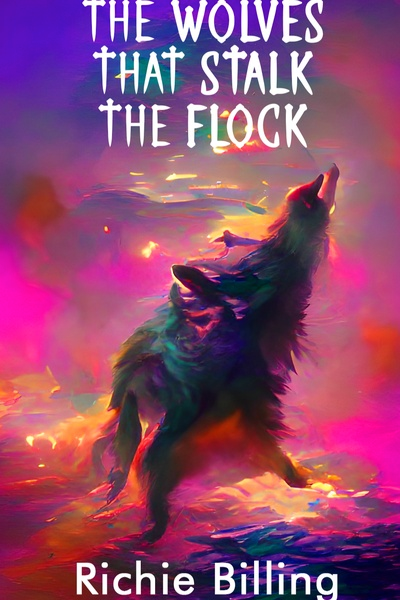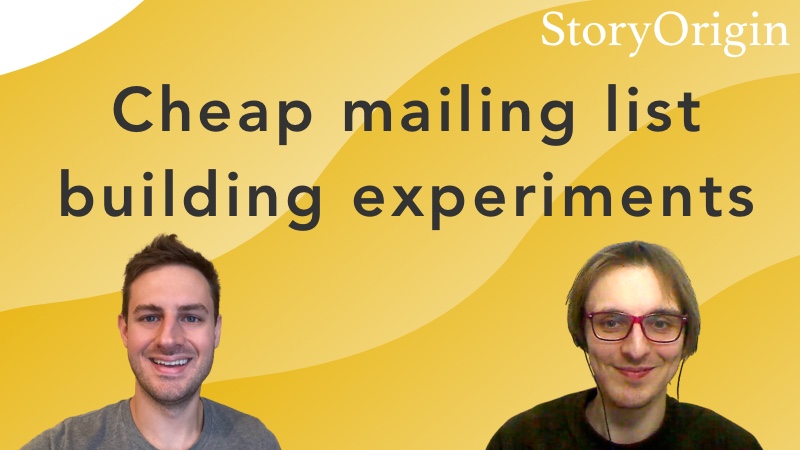Cheap mailing list building experiments
I recently had a great conversation with Richie Billing, lawyer-turned-self-published-author, and why he focuses on self-publishing rather than going to traditional publishers.
He recently ran an experiment setting out to prove to other authors just how affordable it is to build your own audience as a self published author.
He wanted to do it on the smallest budget possible, so the only thing that he paid for in this experiment was his $10 subscription to StoryOrigin.
Here were his steps
- Wrote a reader magnet (a short story to give away to readers that sign up to his mailing list)
- Created a book cover for using an AI image generator called Wombo dream
- Generated an ebook from that using a tool called Calibre
- Entered that reader magnet in cross-promotions on StoryOrigin - Newsletter Swaps and Group Promos
From that small experiment, he initially got 100+ subscribers and has since continued building up to 400 or 500 subscribers.
He's got a lot of other great advice for authors in terms of how to build their mailing list.
And! He's even written his own separate guide to StoryOrigin here.
I've compiled some highlights from that conversation. So let's go ahead and jump right into it.
Publishing Journey
I've been writing for about five or six years.
I picked it up as something that I enjoyed in my spare time. I completely fell in love with it.
It became a daily habit to the extent that I ended up quitting my job as a lawyer to have a go at writing full time.
Then, I ran out of money pretty soon and got a part-time job running an Irish pub.
It's accelerated quite a lot though.
I'm quite happy with what I've achieved and I spend a lot of my time helping other writers overcome the challenges that I encountered.
It's the same sorts of challenges all throughout the career especially if you write the fantasy like I do.
Mailing List Experiments
Recently I've been toying with short stories on StoryOrigin.
I wrote a short story. I was really happy with it and got loads of feedback on it from beta readers.
I sent it out to a few publishers and haven't heard back from most, but those that did send the standard, generic responses.
And I thought, “What am I going to get from it in terms of building a career platform?”
I decided to put it on StoryOrigin as a reader magnet and submit it to group promos and arrange newsletter swaps.
I did that last month, and I've already had 115 emails subscribers just from that one short story.
This is just an example of one of the reasons that I chose to start using StoryOrigin.
I can go directly to readers and cut out the needs for publishers, the need for agents.
If you can build your audience by yourself, then why do you need to go down the traditional publishing route?
Time Invested
Because you can do things so quickly on StoryOrigin, I probably spend less than an hour using it every two or three weeks.
If I was doing it manually, I would spend at least 10-20 hours, because a lot of it is conversations with people, emails back and forth, etc. I don't even know the logistics of how you would do that.
I knew everyone was talking about, “Do you do group promos? Do you do newsletter swaps?”
That's how I found StoryOrigin.
Why a Mailing List
I've used social media and you can talk to people one-on-one, but I don't think it's the same as email.
I have quite meaningful conversations with people over emails.
It is still statistically the best way of engaging with people and selling books because you build a more personable relationship with your followers, as opposed to just having 10,000 followers on Instagram.
Starting a Mailing List
I think first of all: you need to set up a mailing list or a way to gather emails.
I always tell others to use MailChimp, because it's free for up to 2,000 email subscribers and you can set up automations, etc.
Then, set up a really simple stream of welcome emails. For example, “Thank you for joining my mailing list.”
If you've given someone a free thing, give them that there.
Then, over subsequent emails, reveal a bit more about you and ask questions and you might get responses.
Once you've set up your welcome sequence, then I'd set up an account on StoryOrigin, so you can start gathering emails really easily.
Getting New Subscribers
If you've got a short story, create a book file out of that and you can give that away to people who sign up to your mailing list.
Then, join group promos and arrange newsletter swaps.
I've gotten great results: maybe 400 or 500 subscribers based on what I've done so far.
The reason why I say setting up email automations and everything first is because if you haven't got any of that in place, that structure, then you just missing opportunities.
People just join a list and just languish in there.
You need to be engaged.
I'm just a very organized person anyway.
So I always think you need to have a good structure in place first and just tweaking things as it goes as you go along.
It doesn't have to be perfect but you don't want to be missing any opportunities.
With marketing everything is an experiment.
Sometimes a certain formula works for certain people, because the tone of their emails or the way the emails are presented.
There are loads of factors that can influence things but that certain formula has just worked for that person.
We're just giving you suggestions, but it's up to you to experiment.
Don't be disheartened if something doesn't work, because you've got to keep trying different things until you find something that works for you.
Newsletter Template for Cross-Promos
Sometimes I'll do write-ups or put the book's reviews in my newsletter.
I try to sell the book for the other authors as much as I can.
That does work in terms of getting more clicks for people.
Not everyone does that. Some people just stick the book cover in.
That's why you should invest in a really attractive book cover.
Book Cover Experiment
I was messing around with a free AI image generator called Wambo dream.
Loads of people were messing around with it a month ago and they were getting some pretty cool looking fantasy covers.
I ended up using that, going for really vibrant colors to help it stand out.

If you think about group promos, there could be over a hundred books in it and people really only see the covers to start off.
So you might try one cover, see how many requests it gets in a month, then try a different cover how many that gets in a month.
Using these little experiments, then you think, "Well, if this is getting more email subscribers on StoryOrigin, what if I put this on Amazon?" and it might get more sales.
You can use the tests that you do on StoryOrigin and apply the results to other aspects of your marketing.
Book Cover Experiment Results
The point of me doing this was to invest as little money as possible.
The only investment I made in the whole process was the StoryOrigin subscription.
Wombo Dream was the app I used to generate the cover. Just put some simple text over the top of it, and that was it.
I used a free tool called Calibre to generate the ebook and that was it.
The point was to show authors you can do this on the cheap, as cheaply as possible, and all of the expenses were what? $10?
I got a hundred email subscribers. So there you go. That's the metrics there.
Recommendations for New Authors
You've got to put yourself out there.
Some people do unsubscribe when you send emails out, but you can't please everybody.
You've just got to find your people.
One of the best ways to do that is using tools like StoryOrigin, which help you connect with other writers and reach readers without need for things to be published by magazines and publishing houses.
You can just do it all yourself.
It's empowering, because one of the biggest issues people face is they go through the process of self-publishing a book on Amazon, which is really easy to do.
Then they're sitting there like, "Well, no one is buying my book. No one is reading it. So, what's the point in doing it?"
And that's why tools like StoryOrigin empower people.
About the author: Evan Gow is the indie developer of StoryOrigin
